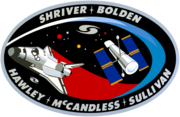STS-31

Discovery deploys the Hubble Space Telescope
|
|||||
| Mission type | Satellite deployment | ||||
|---|---|---|---|---|---|
| Operator | NASA | ||||
| COSPAR ID | 1990-037A | ||||
| SATCAT № | 20579 | ||||
| Mission duration | 5 days, 1 hour, 16 minutes, 6 seconds | ||||
| Distance travelled | 3,328,466 kilometers (2,068,213 mi) | ||||
| Orbits completed | 80 | ||||
| Spacecraft properties | |||||
| Spacecraft | Space Shuttle Discovery | ||||
| Launch mass | 117,586 kilograms (259,233 lb) | ||||
| Landing mass | 85,947 kilograms (189,481 lb) | ||||
| Payload mass | 11,878 kilograms (26,187 lb) | ||||
| Crew | |||||
| Crew size | 5 | ||||
| Members |
Loren J. Shriver Charles F. Bolden, Jr. Bruce McCandless II Steven A. Hawley Kathryn D. Sullivan |
||||
| Start of mission | |||||
| Launch date | 24 April 1990, 12:33:51 UTC | ||||
| Launch site | Kennedy LC-39B | ||||
| End of mission | |||||
| Landing date | 29 April 1990, 13:49:57 UTC | ||||
| Landing site | Edwards Runway 22 | ||||
| Orbital parameters | |||||
| Reference system | Geocentric | ||||
| Regime | Low Earth | ||||
| Perigee | 585 kilometres (364 mi) | ||||
| Apogee | 615 kilometres (382 mi) | ||||
| Inclination | 28.45 degrees | ||||
| Period | 96.7 minutes | ||||
|
|
|||||


Left to right: Bolden, Hawley, Shriver, McCandless, Sullivan
STS-31 was the thirty-fifth mission of the American Space Shuttle program, which launched the Hubble Space Telescope astronomical observatory into Earth orbit. The mission used the Space Shuttle Discovery (the tenth for this orbiter), which lifted off from Launch Complex 39B on 24 April 1990 from Kennedy Space Center, Florida.
Discovery's crew deployed the telescope on 25 April, and spent the rest of the mission tending to various scientific experiments in the shuttle's payload bay and operating a set of IMAX cameras to record the mission. Discovery's launch marked the first time since January 1986 that two Space Shuttles had been on the launch pad at the same time – Discovery on 39B and Columbia on 39A.
Initially, this mission was to be flown in August 1986 as STS-61-J using Atlantis, but was postponed due to the Challenger disaster. John Young was originally assigned to command this mission, which would have been his seventh spaceflight, but was reassigned to an administrative position and was replaced by Loren Shriver in 1988.
...
Wikipedia
